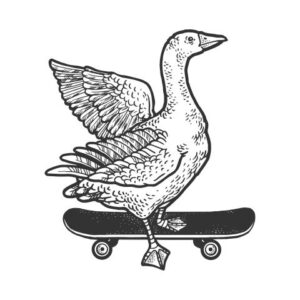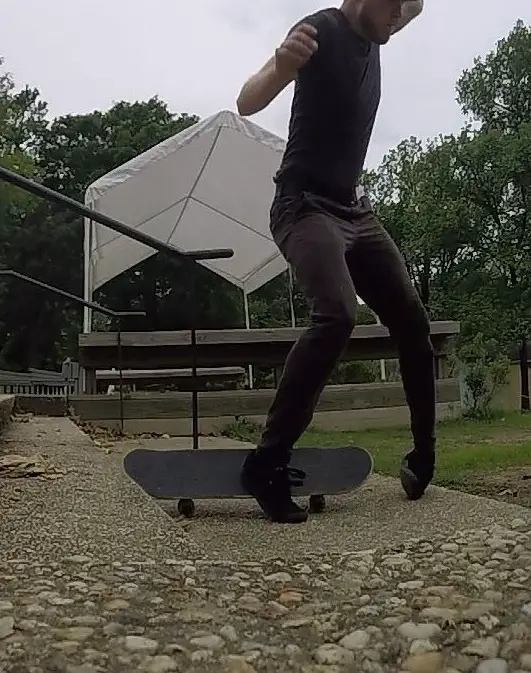The featured image is of me rolling my ankle right after starting to skate again as an adult. It is an example of how not to fall.
If you skateboard you will fall. If you only want to cruise, you will still fall at some point. If you also want to learn tricks, then you will fall often.
So it is pretty important to learn how to fall and not get hurt. The first step is to use protective gear, but without knowing how to fall, the protective gear won’t stop you from getting injured. For some, this comes pretty naturally, but others have little sense about how to hit the concrete.
I don’t want to scare you, but if you can’t fall properly then you’re much more likely to sprain and break your wrists, ankles, and even arms and legs. Not to mention how landing backward on your head can cause lifelong disability or even death.
So, learning to fall properly is important. Let’s get started going over the proper technique.
Enjoy my staged falling gifs.
How to Fall Safely While Skateboarding
Fall Forward
If at all possible, falling forward is almost always better than falling backward.
This is because you can see what is in front of you and fall accordingly. You can also more easily avoid hitting your head, whereas falling backward is a huge risk for a head injury and head injuries are the worst kind. A head injury could leave you with memory loss and increase the risk of dementia later on in life.
To fall forward, make sure you lean into the tricks you are trying to do. This is important to do tricks with proper form anyway as leaning back will cause issues controlling your board. You can also kick your board behind you as you fall.
If you need to get pads to skate in or have protective gear questions, check out our comprehensive guide here.
Tuck In Your Elbows
Tucking in your elbows serves a couple of purposes. You don’t want to land directly on a hard joint like your elbow or knee and it encourages you to avoid trying to catch your fall with your arms.
Both are equally important. A hard fall onto your elbow with no pads can easily fracture or break it. You can also get elbow bursitis which is kinda nasty to look at, but not as serious as a break. Bursitis refers to a fluid-filled sac occurring on the tip of the elbow due to an impact.
Try to land with your elbows tucked in and roll along your side to distribute the weight if possible. Often this won’t be possible, because if you were in control, it wouldn’t be a fall. Falling hard onto your upper arm or side is ideal. It’ll hurt and you’ll get bruised, but you won’t be seriously injured.
Land On Your Butt and Keep Your Head Up
If you fall backward, just fall on your butt. Keep your head up and away from the ground at all costs. Falling on your butt is perfect. It’s squishy, you won’t get seriously hurt, and it’s not so painful. This is the ideal. Sometimes it is not possible to do this.
The main risk is that falling backward is somewhat of an unknown. If you are skating in a skatepark, a parking lot, or an open area then it will probably be fine to fall backward, but there is always the risk of hitting a curb or something hidden behind you. Hitting your head is the biggest no-no in skating. Head injuries bleed quite a lot and have much more serious life implications than breaking your arm.
A broken arm won’t kill you. A head injury might.
So land on your butt and slide it out. Fall straight down and keep your head up. A bruised butt is a small sacrifice for a healthy head.
Spread Out Your Impact
Have you ever seen someone tuck and roll when they hit the ground? Maybe you saw a video of army rangers or some on a survivor show doing this. There is a reason for it.
Taking a direct impact is tough on your body and can lead to all sorts of injury or wear and tear on the body. The same goes for skateboarding slams. Especially, considering that skateboarders will be landing on concrete and not grass.
I’m going to be honest though. More often than not, you won’t be able to tuck and roll when you fall. You won’t have the right ankle or you won’t have enough forward momentum. The key here is to transfer some of the impact across your body and not just falling flat on your arm or side.
This might mean catching yourself with a leg and then buckling into a fall. This could mean actually tucking and rolling if it is possible to do so. Just don’t land on your arms trying to soften your fall.
Don’t Land On Your Hands Or Arm
This is probably the number one mistake people make when they fall. It can help to redirect your body with your arms when you fall. However, it is never ok to fall onto your arms. This is simply asking to break something.
Your instinct will be to catch yourself with your hands, and this is often ok as long as you push to the side before you hit the ground. At most, use your arms to turn your body so you fall onto your side. This is wise to do if you are falling straight forward and don’t want to smash your face into the concrete.
Landing directly onto your hands or arms will injure you. Don’t get injured, please.
Use your hands to push or turn your body, but otherwise, tuck in your elbows and just take the fall on your side or on your butt. Save yourself a trip to the ER.
If you keep spraining or landing on your wrist, check out our product review of 187 Killer Pads wrist guards here.
Kick Your Board Away
I remember one of the silliest and most frustrating ways I sprained my ankle. I had never skated a kicker before and I was feeling great that night. My tricks were landing and even though I had only recently gotten back into skating, I felt confident.
So a cruised up to the kicker and rode up it just intending to ride-off it. No ollie and no other trick. I didn’t really have enough speed and at the last minute, I tried to step off of my board instead of land on it. This was a silly mistake and my back foot caught the edge of the board turning it enough to badly sprain my ankle.
I had learned an important lesson. If you are going to bail on a trick, kick the board away. Otherwise, don’t bail.
If I kicked the board away, I would’ve been fine. If I had just tried to land it anyway, I would have been fine. Yet, trying to land on the ground with a board still underneath you is a disaster waiting to happen.
I felt so frustrated from that ankle sprain because it was from me not even trying to land the trick and it could’ve been avoided.
Kicking the board way is as simple as it sounds. Just kick out and away from your body and your board will go shooting away from you. This is easy for me because I accidentally kick the board away on half of my tricks anyway.
Stay Loose
This one could go without saying but is somewhat important so I’ll be explicit here. Stay loose when you fall and do not tense up or go rigid.
Tensing up could cause all sorts of injuries from muscles tears to sprains, to broken bones. Just be flexible and loose and follow the momentum. You don’t want to catch yourself all at once. It may seem scary, but being loose and flexible will help you walk away uninjured from your falls.
How to Practice Falling While Skateboarding
Most of your feeling for how to fall will be built up naturally over time as you learn to skate and take some falls. I never deliberately set out to learn how to fall, but now I rarely ever get injured and can fall pretty reliably in a way that I can easily walk away from. I still occasionally sprain my wrists, but I’ve never broken a bone.
The best way to practice a fall is on a soft surface while simulating the real thing as best as you can. I recommend that you find a spot where concrete meets grass and then roll up to the grass and then fall into the grass. The grass will catch and stop your board and you can learn to fall loosely and safely into the grass.
I don’t recommend really practicing on concrete because concrete hurts. You won’t want to do too much practice on that surface, but you will get some practice as you naturally take some falls while trying to learn.
Learn Skateboarding Gradually
This is a full heading instead of a subtitle because I think it is so important.
Don’t start skating and instantly try difficult tricks. Don’t start by learning to drop in or bomb hills. Don’t try to grind rails or skate stairs when you just learned how to ollie. Learning to skate takes years and years to do.
If you push yourself too fast, then you will increase the chances of you getting injured. Take it really slow. It takes a beginner on average more than a month to learn an ollie and even longer to get it consistent. There are also tons of intangible skills that you’re learning. One of these intangible skills is learning how to fall.
So please please please don’t push yourself so hard. There’s no need to instantly try to learn kickflips. Even if you learn them they won’t be steezy and will look awkward as you will have a poor board feel.
Be patient. Skateboarding, like most things, is a marathon and not a sprint. Skate at your level.
If you’re knees hurt after a long skateboarding session, check out the reasons why and how to prevent painful knees here.
Other Resources
I am by no means the ultimate authority on skateboarding. I hope my guide is helpful to you, but if you need more check out these other fantastic guides.
Conclusion
Learning to fall isn’t so easy to do. For some, it may come naturally, but it will likely take some nasty slams before you really get a feel for how to bail out or take a fall properly.
Just try and practice some of the basic falls such as landing on your butt, tucking in your elbows, and tucking and rolling. Kicking away the board is a good skill to practice as well as it can help avoid ankle sprains. I didn’t talk about falling while skating bowls and transition as falling is totally different in this situation because you will slide on your kneepads into the bowl or ramp.
So that’s it. I hoped you enjoyed reading my tips and seeing me fall. Try and practice these falls on something soft and then on concrete if you have pads. It could really save you months of injury if you do.
Anyway, thanks for reading, and look out for more articles from Board and Wheels.



